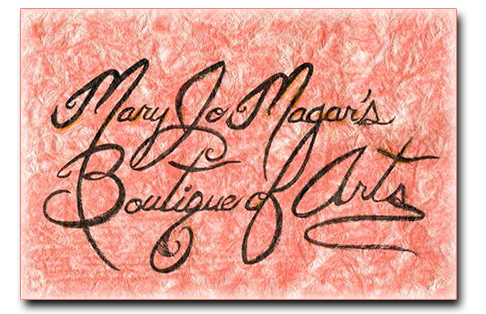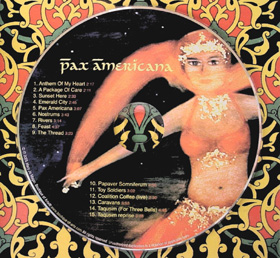winner of the 2006 Los Angeles Music Awards Album of the Year, Independent category
Pax Americana CD album,15 tracks, written (music and lyrics) and produced by Mary Jo Magar, 2005
vocals: Sargon Isho: tracks 1, 3, 5, 6, 7, 8, 9, 11, 13, 14:
vocals: Diane Ellis: tracks 2 and 4
vocals: Mary Jo Magar: tracks 10 and 12
Track List:
1. Anthem of My Heart
2. A Package of Care
3. Sunset Here
4. Emerald City
5. Pax Americana
6. Nostrums
7. Rivers
8. Feast
9. The Thread
10. Papaver Somniferum
11. Toy Soldiers
12. Coalition Coffee (live)
13. Caravans
14. Taqusim (For Three Bells): Judaism, Christianity, Islam
15. Taqusim reprise (carillon for three bells)
The concept for a Pax Americana (U.S.-dominant globalism and peacekeeping) was outlined in the text of President George W. Bush’s declaration of policy titled The National Security Strategy of the United States of America released on September 19, 2002. The plan states that “the U.S. national security strategy will be based on a distinctly American internationalism . . . In exercising our leadership, we will respect the values, judgment, and interests of our friends and partners. Still, we will be prepared to act apart when our interests and unique responsibilities require.”
Why the album Pax Americana was made . . .
Throughout the Arab world, music with dance is traditionally considered common custom, not theatrical performance.
Unlike Occidental dance forms, especially ballet, which are choreographed for predigested acceptance by an impersonal audience, traditional Oriental dance derives primarily from self-expression and thus improvisation while at the same time being culturally and collectively inspired. Musicians play and dancers dance for themselves and for an audience but for neither separately; rather the nature of these pleasures is not exclusively entertainment or art, but inclusively an emotional and spiritual collaboration – a synthesis – between participants and spectators alike. The music and the dance build their power from the intimate enjoyment and encouragement of the spectators who are as much creators of the experience as those playing instruments and those dancing.
It is understandable then that from the Arab perspective, all people, by virtue of self-expression, are capable dancers, not just a select few who are “talented” or “trained.”
Metaphorically, by extension, one can extrapolate that all nations, and all cultures therein, are capably rich. Resources vary, but wealth does not when viewed as a relative fundamental rather than an absolute standard.
Just as the self-expression of one person differs from that of another – even when “choreographed” by degrees of cultural, economic, and/or generational determinism, etc., – the wealth of one nation may seem the poverty of another while the principle of wealth alone remains nonetheless applicable to all nations by different self-expressions.
Specifically, wealth expressed as economic and military superiority can simultaneously be a wealth of ethical and spiritual impoverishment. Conversely, spiritual and cultural wealth can simultaneously be a wealth of vulnerability to aggression from material, martial forces.
The impersonal intent for the album Pax Americana and the reason for the title’s depiction as an Oriental dancer is to contrast by mixed comparison two separate expressions of wealth: the American “superpower” and the Iraqi/Persian/Arabic/Mesopotamian supercultures.
A war or conflict without music, poetry, art, and literature is an even greater tragedy than war itself.
In remembering the major wars and conflicts of the twentieth century, one also remembers the artistic output that they inspired. However, because artistic expression is dependent upon idealism functioning at a greater capacity of influence than realism, it is of little surprise that with each successive war or conflict, the ideals of those most coarsely involved become influenced by the realities of those who came before; thus, idealism in relation to war becomes progressively more defined by peace as a state to be maintained pragmatically, not fought for or compromised unreasonably.
There is nothing beautiful about war or conflict; however, the emotions and sentiments awakened in people during such times of strife can be beautiful, even when painful, and it is these emotions and sentiments that the beauty of music, poetry, literature, and visual and performing arts can capture and hold in time as memorial to events of date as well as memorial to the ultimate futility of conflict and war.
Art as a whole has the unfailing ability to extract Truth and Beauty from even the worst of circumstances. Such is art’s infinite gift to the world.
The songs of Pax Americana along with the album’s artwork and booklet are intended as artistic memorial to those who have served in Operation Iraqi Freedom, meaning all those internationally in civilian and military service who have been or are deployed in Iraq as well as all taxpaying Americans who have knowingly, but not necessarily accordingly, contributed to their country’s initiative in establishing a dominant presence in Iraq.
Moreover, the album’s song titled “A Package of Care” is of special significance because it commemorates the voice of women in the military. The song is dedicated to women of service throughout the world now and throughout history who, even today, remain lesser-known soldiers, like the women among the four caliphs of Islam and the Hamzar tribe who, on foot and horseback, led armies and fought with sabers side by side with men.
War songs of yesteryear were commonly written from one of three perspectives: the voice of the country or nation; the voice of the soldier, who may have been a woman but only the woman herself would have known because women were not previously regarded as combatants even though many functioned as such; and finally the voice of the mother, wife, or girlfriend keeping the home fires burning while also perhaps doing her part at the home front or engaged at the war front in an “idealized” role (such as nursing) however ugly or dangerous in reality.
The song “A Package of Care” lets the feminine voice sing out with a direct perspective of active duty in Iraq but with a no less feminine perspective of being far from home and far from the accoutrements of femininity.
Furthermore, the best known war songs of history were written by men. All the songs for Pax Americana were written by a woman, and the album itself was produced by a woman.
About the music itself . . .
Among the consequences of conflict on foreign soil is exposure of invaders, or “liberators,” as the case may be, to the geography and cultural fabric of the locale being occupied.
Whether for good or ill (or both), troops of military force never forget the places in which they have fought or that they have occupied, for the soldier is the most “accidental” of all tourists and among the most profound in his/her legacy of memories.
For this reason, and given that the Middle East has a rich culture of ancient musical traditions, five of the album’s fifteen songs, including the title song “Pax Americana,” were written and arranged for adaptation of Iraqi, Persian, and Arabic music to Western standards of musical structure.
Authentic traditional Iraqi, Persian, Arabic, and Afghan instruments were used in recording, and several songs besides the aforementioned five have accents of these instruments within their arrangements.
In particular, the song “Coalition Coffee” was recorded for the purpose of imitating authentic use of the Arabic mihbaj, the song’s solo instrument, which is a coffee grinder that Bedouin tribes use to grind coffee beans and also to create percussion for entertainment, singing, and dancing.
The Featured Vocalist . . .
The original intent for the Pax Americana album was to present voices of American military and civilian veterans, male and female, of Operation Iraqi Freedom. More than a year was spent in earnest, extensive attempts to fulfill that intent, and during that time, some voices (veterans) were found, but in each case circumstances ultimately left the intent unfulfilled. The decision was finally made to release the album with its demonstration vocals; however, in the course of preparing for release, a talented young man was met, Sargon Isho, who became not only the album’s featured vocalist but the coincidental embodiment of part of the album’s dedication.
Sargon Isho is a first-generation Iraqi American whose mother and father were born in Baghdad, Iraq and in youth immigrated to the United Sates to escape persecution for their Christian faith. Sargon is a 2005 graduate of Indiana University, with a degree in Music Performance for trumpet. Having also majored in voice, Sargon performed in his junior and senior years with Indiana University’s prestigious men’s a cappella group Straight No Chaser.
Though none of the album’s three vocalists have served in Operation Iraqi Freedom by having served in Iraq, they nonetheless serve as Americans in the sense of being affected by their nation’s courses of action, or in proverbial words, they also serve who stand and {sing}.
May the voices of all those internationally, in both military and civilian service, who are now in Iraq, as well as the voices of all those who have served and returned or served and not returned alive, sing through the songs and voices on the Pax Americana album.
The CD booklet . . .
The 48 page booklet accompanying the Pax Americana album contributes original artwork, poetry, photographs, and fascinating current and historical information to the commemorative purpose of the album. Included in the booklet are the full lyrics to every song.
Half of all sales profits donated to the Iraq War Veterans Organization.

